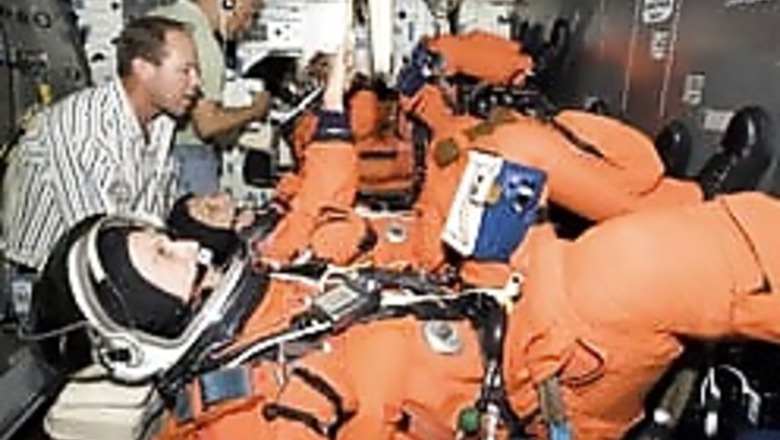
views
Washington: The seven crew members of the space shuttle Discovery arrived at Kennedy Space Center on Tuesday to begin training for a spaceflight next month in which each will have a 1-in-100 chance of dying.
Those are the official odds that NASA has long given. Exactly what the real odds are is a question that looms larger than normal this time.
That is because two top officials at NASA took the unusual step of dissenting from the space agency's decision to go ahead with the launch without correcting the potentially catastrophic problem of foam falling from the external fuel tank.
That was the problem that doomed the Columbia 3 1/2 years ago. The agency's safety director and chief engineer wanted to wait and repair the problem.
NASA Administrator Michael Griffin decided, however, that a July 1 launch was worth the added risk for a variety of reasons.
"It's a difficult decision, highly technical, highly subtle, very subtle, involves lots of assessment of statistical risks," Griffin said in an interview with The Associated Press. "We spent weeks on this decision."
In engineering geek-speak, what they did is called "risk analysis." In everyday life, it's making up your mind about seemingly ordinary things that could be deadly. Will that car trip end in a fatal crash? Will that extra dessert or cigarette lead to life-shortening health problems?
"What's really instructive is the way the various players in this controversial choice - from the head of NASA to the safety director to the astronauts themselves - are not only using the facts but their individual unique perspectives in trying to figure out what's right or what's safe," said David Ropeik, risk communications instructor at the Harvard School of Public Health.
He is co-author of the book "Risk: A Practical Guide for Deciding What's Really Safe and What's Really Dangerous in the World Around You."
Humans have gone into space 717 times, and 18 astronauts and cosmonauts have died doing it: the seven Challenger astronauts, the seven aboard Columbia, and four cosmonauts in two Soviet accidents. (The total does not include the three astronauts who died in a fire during a launch-pad test aboard Apollo 1 in 1967.)
Discovery astronaut Mike Fossum described how his family is dealing with the risk: "I have to look my wife in the eye. We've had those discussions. It's not one she is really comfortable with. It's not one anybody really is."
Fossum's crew mate Stephanie Wilson, about to fly for the first time, joked that 1-in-100 odds are better than 1-in-99, but added: "Seriously, all of us train for our mission, and we recognize there is a risk."
Michael Stamatelatos, who as director of safety and assurance requirements at NASA is the agency's risk guru, said NASA's 1-in-100 odds for the loss a vehicle and its crew should be taken with a grain of salt, because NASA used to say the chances were 1 in 7,000 until Challenger proved that to be overly optimistic.
"Now we know that's not true," Stamatelatos said. "That was based on insufficient information." He said there are too many uncertainties to say precisely what the odds might be this time.
The more NASA studies what goes on, the more the agency finds that the risks were really far higher than originally thought, because so much more could go wrong than engineers figured, said Paul Fischbeck, a Carnegie Mellon University engineering and decision sciences professor.
At the same time, problems are being fixed, so the shuttle is getting safer to fly than before, he said.
Fischbeck, a former military pilot, said he is disturbed by NASA's decision to go ahead and launch. He said the foam hit that caused a fatal hole in the Columbia's heat-protection layer in 2003 took the agency completely by surprise.
Engineers thought they had repaired that problem before Discovery's return to flight last summer, only to find another foam problem.
"Both those things should be shaking their engineers to the core," said Fischbeck, who has consulted with NASA on the shuttle heat shield risk. "You're flying with stuff you know is not going to work right."
The uncertainty about the foam worried NASA safety chief Bryan O'Connor. He dissented from the launch decision but did not appeal, because NASA has drawn up plans to send the crew to the international space station to await rescue if the shuttle skin should be damaged.
O'Connor, a former shuttle commander, helped investigate the Challenger accident and was in his safety chief job less than a year when Columbia disintegrated as it soared toward its landing.
Shuttle program chief Wayne Hale argued in favor of flying Discovery now, saying all sorts of changes that already have been made to the foam need to be tested in flight before more complicated modifications are made.
The final decision rested with Griffin, who said that because everyone agreed the crew could survive on the space station, the risk was more to the space program than to the astronauts.
He weighed what he said was the small added risk in lifting off now against the larger safety risk of rushing launches at the end of the decade. If Discovery's launch were delayed, NASA would be in hurry to complete its goal of finishing space station construction with 16 launches by 2010. Pushing everything off, Griffin said, "would be really dumb."




















Comments
0 comment